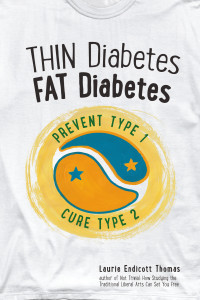In Chapter 16 of “Thin Diabetes Fat Diabetes” Laura Endicott Thomas begins by stating:
“Genes have at most a small influence over whether a person gets thin diabetes (type 1 diabetes) or fat diabetes (type 2 diabetes). The truly genetic forms of diabetes are rare.”
Endicott Thomas goes on to describe two categories of monogenic diabetes and another rare form of diabetes that is not purely genetic.
Maturity Onset Diabetes of the Young (MODY)
Maturity Onset Diabetes of the Young (MODY) is one category of monogenic diabetes. “Monogenic” means that the diabetes can be traced to a single defective gene. MODY represents less than 2% of all diabetes cases and is commonly misdiagnosed as type 1 or type 2 diabetes. MODY can be inherited from either biological parent.
As Endicott Thomas explains on page #159 in “Thin Diabetes Fat Diabetes”:
“Clinically, MODY is like a cross between thin diabetes (type 1) and fat diabetes (type 2). The pancreas produces enough insulin to keep the patient alive, but not enough to keep blood sugar under good control. Doctors suspect MODY when they have a young, thin patient who has high blood sugar that never seems to progress to full blown thin diabetes (type 1). This explains why these patients can get by on tiny doses of insulin and why they don’t get terribly ill if they miss a dose of insulin.”
There are several forms of MODY. Some are so mild that no special treatment is needed. Some forms are treated with drugs that stimulate the pancreas to secrete more insulin and some forms require insulin treatment.
People with MODY are at risk of developing the typical long term complications of diabetes, such as blindness, kidney failure, heart disease, poor wound healing, and neuropathy. Like people with other forms of diabetes, MODY patients can reduce their risk for these complications by following a low fat whole food plant-based (WFPB) diet.
Neonatal Diabetes Mellitus (NDM) or Infantile-Onset Diabetes Mellitus
The second form of monogenic diabetes is much rarer than MODY. Neonatal Diabetes Mellitus (NDM) occurs in the first 6 to 12 months of life. NDM is a rare condition occurring in 1 out of every 400,000 babies. Babies with NDM do not produce enough insulin and therefore need insulin replacement therapy. NDM is often mistaken for type 1 diabetes, but type 1 diabetes is very rarely seen before 6 months of age. Diabetes that occurs in the first 6 months of life almost always has a purely genetic cause. Researchers have identified a number of specific genes and mutations that can cause NDM. In about half of those with NDM, the condition is lifelong and is called permanent neonatal diabetes mellitus (PNDM). In the rest of those with NDM, the condition is transient, or temporary, and disappears during infancy but can reappear later in life. This type of NDM is called transient neonatal diabetes mellitus (TNDM).
Latent Autoimmune Diabetes of Adults (LADA)
Although Latent Autoimmune Diabetes of Adults (LADA) is not a purely genetic disease, it is a rare diagnosis. In fact, leading medical organizations do not use or recognize LADA as a diagnosis. These organizations include: the American Diabetes Association, American Association of Clinical Endocrinologists, American College of Endocrinology, World Health Organization, Centers for Disease Control, and National Institutes of Health. The only professional diabetes organization that officially recognizes LADA is the Immunology of Diabetes Society. It defines LADA as:
- Diagnosis of diabetes in a person over 30 years old.
- Presence of any islet cell antibody.
- No insulin needed for at least 6 months.
Like type 1 diabetes, LADA is caused by the immune system destroying the insulin-producing beta cells in the pancreas. Unlike type 1, however, this destruction is a somewhat slow process. For some patients, oral medications or very tiny amounts of insulin may be effective for a while.
Many experts believe LADA and type 1 diabetes are different diseases. Others say that LADA is a form of type 1 diabetes. Some think the LADA label should be thrown out altogether.
Because LADA doesn’t fit neatly into a shoebox, many patients with LADA are misdiagnosed and wrongly treated. It is frequently mistaken for type 2 diabetes. This leads to inappropriate therapy, especially a delayed start of insulin. Initial treatments for type 2 diabetes that include oral medications and lifestyle change may initially work, but the treatments will eventually begin to fail. A formal diagnosis of LADA would include insulin antibody tests, but in the absence of any diagnostic criteria for LADA, this is rarely done in the trenches.
LADA sufferers, misdiagnosed as type 2 diabetes patients, may fastidiously follow doctors’ orders and initially respond favorably to treatment. However, even if they follow a whole food plant based (WFPB) diet and exercise regularly, they will eventually require insulin replacement therapy. The pancreas’s ability to secrete adequate insulin declines over time.
The benefits they will get from being active and following a WFPB diet are the same benefits that type 1 diabetics get — reduction in the risk of developing diabetic complications and a reduction in the amount of exogenous insulin they’ll need to maintain glucose control.
It appears that a WFPB diet is the best choice for all types of diabetes, even the rarest types.






 E Excerpt from Laurie Endicott Thomas’s amazing book Thin Diabetes – Fat Diabetes by clicking here!
E Excerpt from Laurie Endicott Thomas’s amazing book Thin Diabetes – Fat Diabetes by clicking here!
Speak Your Mind